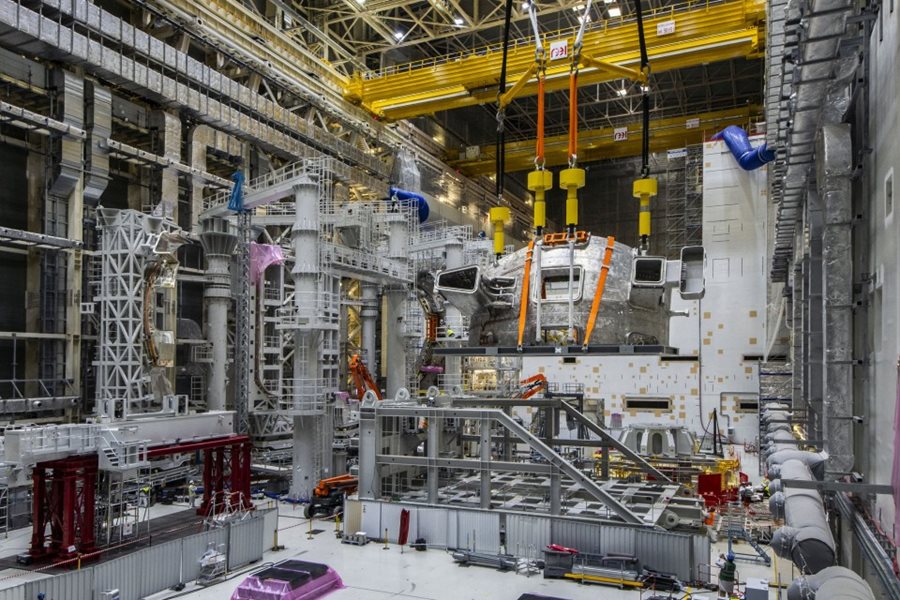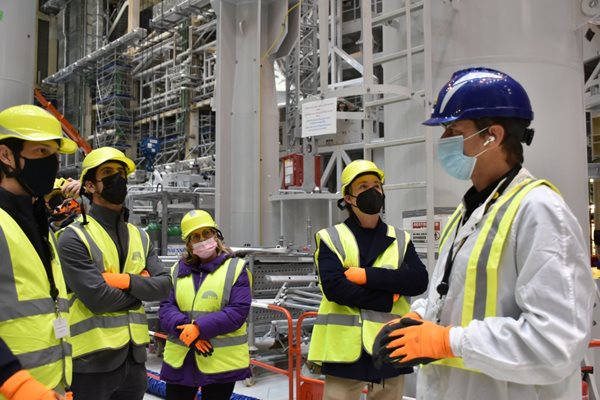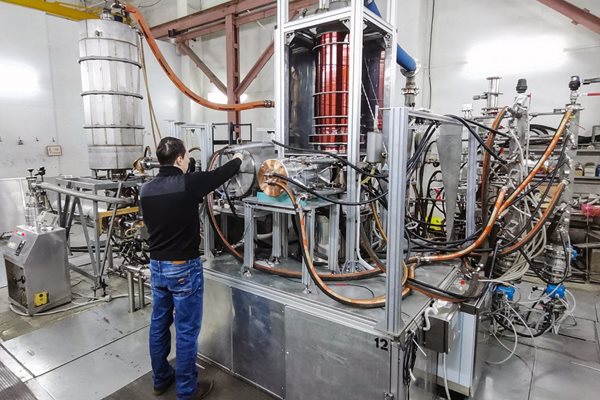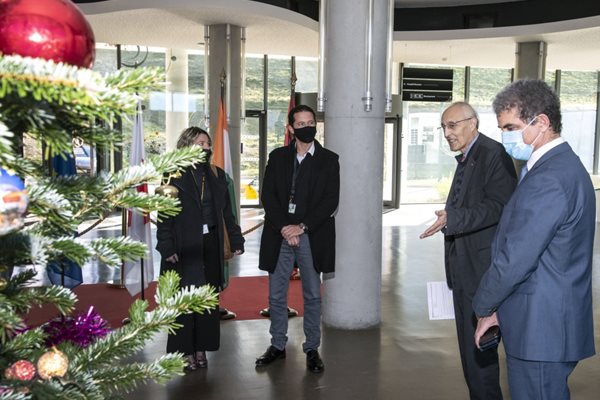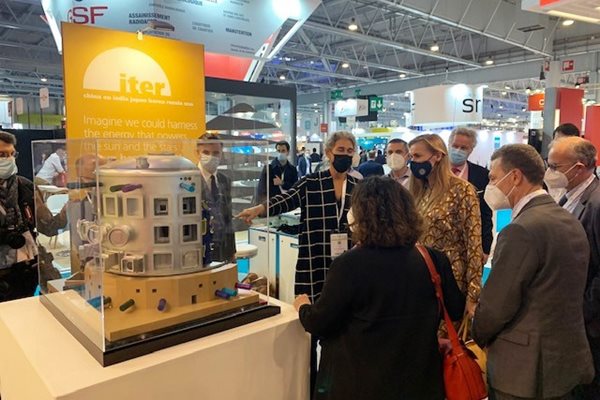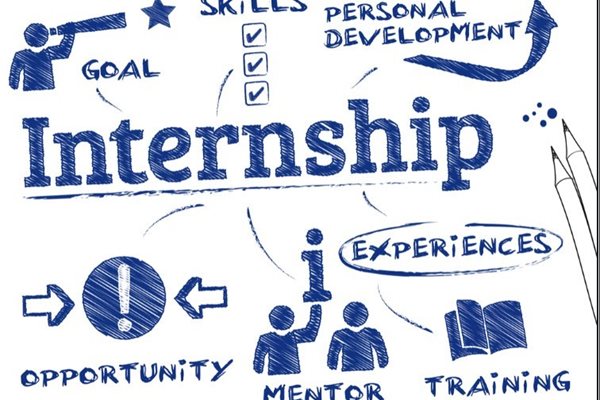
you're currently reading the news digest published from 29 Nov 2021 to 06 Dec 2021
featured4
of-interest3
press20
featured
Vacuum vessel | Another day, another sector
'Construction work packages,' which detail the succession of individual tasks to be performed for each and every ITER assembly activity, read like a preflight check list: Upper counterweight? Installed. Lashing lines? Installed. Metrology diagnostics? Completed. Shim plates? Installed. Stability blocks? All in place... The sequence might not end with the words 'Takeoff!' or 'Ignition!' resounding in the public address system. But somewhere, among the dozen people involved in the operation, someone is giving the 'Go!' and a massive component slowly, almost imperceptibly, begins its ascent. For the second time in less than a year, a 40° vacuum vessel sector has entered the sub-assembly sequence. The first activity was performed on Thursday 2 December with the lifting of the 440-tonne component from the work platform into the upending tool. The transition from horizontal to vertical by way of a 90° mid-air tilt is planned in the coming days and the docking in the sub-assembly tool (SSAT1) the following week. Operations similar to those performed since April 2021 in the adjacent tool (SSAT2) will follow and in a few months time a second sub-assembly, or 'module,' will be ready for installation in the Tokamak pit. Lessons learned from the lift of the first sector, in March 2021, resulted in 'a better understanding of the fitting operation of the component into the upending tool,' says Alex Martin, head of the ITER Vacuum Vessel Section. 'We realized we could have a smoother process by dismantling some sub-components prior to the lifting and reinstalling them afterwards before the upending.' One of the challenges of lifting and positioning such a heavy and contorted component lies in determining its precise centre of gravity and adjusting the rigging accordingly. The fine-tuning of the system is performed by four hydraulic 'sync hoists' attached to a pair of load-balancing beams suspended to the crane hooks. 'Once the load is perfectly balanced, we need to ensure that the sector and its lifting frame will be precisely oriented in the direction we need during the upending movement. For that, a bit of reverse engineering is required, like the shimming of the interface components between lifting frame and sector,' says Martin. With the success of the second vacuum vessel lift operation part one, the teams are growing more confident. 'At the end of the day,' says Martin, 'it just felt like ... a normal work day.'
Nico Rosberg | Racing towards a sustainable future
He might have retired from the active life of a racing driver, but Nico Rosberg—Formula 1 World Champion in 2016—has chosen not to hang up his hat. His new ambition is to contribute to an environmentally sustainable future for all. Since his retirement from active racing, Rosberg has embarked on a career as sustainability entrepreneur and investor in green technologies and mobility start-ups. He is a founder of the Greentech Festival, a platform for events to promote new sustainable technologies; he is also an investor and shareholder in the all-electric racing series Formula E. His Rosberg X Racing team—competing in Extreme E—is one of 250 teams participating in the United Nations Sports Action for Climate Change initiative, under which sports teams are striving to reach CO2 neutrality by 2040 (even earlier than under the Paris Accords). He believes that sport has the power to connect to people. 'It is a great platform to take people along on this journey to combat climate change.' Last Wednesday, Rosberg accepted the invitation of two of his racing colleagues, Lucas di Grassi and Bruno Senna, to tour ITER. Rosberg had only recently read about ITER in a book by Bill Gates and was intrigued by the project. What impression did he take away from his visit? Naturally, he was drawn in by the technical prowess of the construction and assembly activities he witnessed. But most of all, he was impressed by the unique international collaboration of the 35 countries that make up ITER. 'It gives me a lot of hope to see the world coming together for a project that could change humankind for a long time to come.'
Manufacturing | Russia ships auxiliary heating equipment
The energy-generating devices of ITER's electron cyclotron heating system—gyrotrons—require a number of auxiliary systems such as water cooling equipment, cryocoolers and microwave-beam forming systems. A first batch of auxiliaries is on its way now from Nizhny Novgorod, Russia. At ITER, two radio-wave-generating systems are designed to deliver 40 MW of input heating power to the plasma: the electron and ion cyclotron heating systems. The systems deliver energy at frequencies that match the oscillations of particles inside the plasma—a matching called "resonance." The energy increases the velocity of the particles' chaotic motion, and at the same time their temperature. At the core of electron cyclotron resonance heating (ECRH) is the microwave-generating gyrotron. In a gyrotron, beams of electrons are accelerated toward a cavity where a strong magnetic field is applied. The interaction between the rotating (cyclotron) motion of the electrons and the magnetic field generate high-frequency radio waves that "travel" in a straight line into the plasma, almost like an optical beam. Russia is manufacturing 8 of the 24 gyrotrons required by ITER. Six gyrotron complexes have already been completed, of which four are required to be on site by First Plasma. The Institute of Applied Physics of the Russian Academy of Sciences has been engaged in the development and scientific guidance for the creation of these unique devices, while their fabrication is carried out at the GYKOM enterprise in Nizhny Novgorod. A first batch of auxiliary equipment was dispatched on 1 December. According to the ITER schedule, delivery of gyrotrons, power supplies, control systems, as well as the start of equipment assembly at the ITER site is planned for 2022.
Image of the week | New mayor observes ITER Christmas tradition
Every year since the ITER Organization moved into its Headquarters building in November 2012, the tradition has been observed. A few weeks before Christmas, the mayor of Saint-Paul-lez-Durance, where the organization is administratively located, sends a large Christmas tree and comes a few days later to symbolically light its baubles and garlands. Over the years, the mayors have changed but the tree has always been delivered. On Wednesday 1 December, Mayor Romain Buchaut, who was elected in September 2021, came to ITER with his one of his deputies, Élise Place, and—together with ITER Director-General Bernard Bigot—pressed the button that illuminated the tree. As a specialist in land planning and development, Mayor Buchaut said he was very eager to strengthen the relationship between ITER and the municipality he is heading. He stressed the very unique situation of Saint-Paul-lez Durance—a village of less than one thousand inhabitants that, thanks to ITER, the neighbouring French Alternative Energies and Atomic Energy Commission (CEA), and their many contractors—offers close to 10,000 full-time jobs on its territory.
of-interest
SOFE 2021 goes virtual
The 2021 Symposium on Fusion Engineering (SOFE) will take place exclusively on line from 12 to 16 December 2021. It will be co-located on the same virtual platform as the IEEE Pulsed Power Conference (PPE), offering participants enhanced opportunities for social and technical interaction. Held biennially since 1965, SOFE is coordinated by the Fusion Technology Committee of the IEEE/NPSS (Institute of Electrical and Electronics Engineers/Nuclear & Plasma Sciences Society). The Symposium is dedicated to the scientific, technological and engineering issues of fusion energy research and is a mixture of oral presentations and poster sessions. Head of the ITER Engineering Domain Alain Bécoulet will be presenting the status of ITER assembly in the Opening Plenary. Other ITER presenters will discuss tokamak assembly, diagnostic engineering and integration, and the ITER in-vessel coils. There is still time to sign up at PPC-SOFE 2021.
ITER at the World Nuclear Exhibition 2021
ITER was represented earlier this month at the world's largest exhibition dedicated to the civil nuclear sector—the World Nuclear Exhibition (WNE), which was organized in Paris and virtually from 30 November to 2 December 2021. WNE brings together the global civil nuclear community once every two years for networking and discussions of the major challenges facing the industry and society. This year's edition, which attracted more than 600 exhibitors from 83 countries and approximately 18,000 participants, was organized around the theme "The nuclear industry, a key partner for a low-carbon society in a responsible future.' Organizers highlighted the role that the global nuclear sector can play as a "steerable, non-intermittent, and competitive" source of electricity in the fight against climate change and the effort to move toward a sustainable low-carbon-emissions future. "R&D in new technologies and concepts are stimulating the sector as well as business and job prospects and competitiveness within the entire value chain," stressed WNE President Sylvie Bermann. In her address on the opening day, European Commissioner for Energy Kadri Simson placed ITER squarely in the category of "disruptive innovations. "The benefit for international scientific collaboration and the potential spill-over effect for technological innovation is hugely significant." At the ITER stand, in space shared with the European Commission and the European Domestic Agency Fusion for Energy, there was a steady stream of interested visitors over three days. The most common question from nuclear industry representatives was: "How can we get involved in fusion?" (Photo: Philippe Eranian)
Apply now for an ITER internship
The ITER Organization has kicked off its 2022 internship program with the publication of 68 offers on the ITER website (visit Jobs/Internships here: https://www.iter.org/jobs/internships). These opportunities are geared toward undergraduate and postgraduate students, with a broad array of topics across scientific, technical and support departments. Science, technology, systems engineering, business operations, and construction and installation are all represented in this year's batch of internship opportunities. Positions are offered for up to six months; some categories are extendable to one year. Apply before 16 February 2022 (or 16 January 2022 for internships beginning in Q1 2022) through the online e-recruiting system. (Please note that internship opportunities are limited to nationals from countries participating in the ITER Project, i.e., China, the European Union, India, Japan, Korea, Russian Federation and the United States.)
